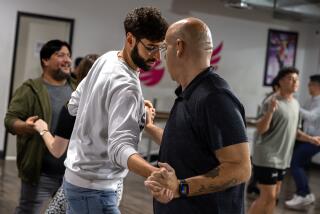A sleek stretching of styles
- Share via
An authentic, serious new voice in dance, Victor Quijada, a native son of L.A., has created an exciting, seemingly improbable fusion of hip-hop, ballet and modern dance. He has taken the energy and virtuosity of street dancing and married it to the formal structures of concert dance, and he’s done it with a probing sense of musicality, a respect for the individuality of his dancers and an ability to evoke meaningful character interactions.
All this was on view when Quijada’s virtuosic six-member Montreal-based company, Rubberbandance Group, named after his own street moniker, appeared Saturday at Cal State L.A.’s Luckman Theatre. The program, titled “Elastic Perspective Redux,” consisted of seven works commissioned by hip-hop dance and contemporary dance festivals in Canada, Europe and the U.S.
It was a joyous homecoming for Quijada, 32, who started street dancing in Baldwin Hills when he was 8. His circle of influences began widening as he studied under postmodern icon Rudy Perez at the Los Angeles County High School for the Arts, joined Perez’s company for two years, then got swooped up by Twyla Tharp for three years. In 2000, he settled in Montreal, where he danced with Les Grands Ballets Canadiens de Montreal for two seasons. In 2002, he founded his own company.
The evening began with “Secret Service,” a piece set to the cushion dance from Prokofiev’s score for the ballet “Romeo and Juliet.” Prokofiev’s music is weighty, ponderous, ominous, embodying the repressive social forces that will crush the love of Romeo and Juliet.
Quijada’s knockout choreography matched the music with aggressive force as a phalanx of five street fighters advanced toward the audience with inventive punches and kicks, men and women being equal-opportunity warriors.
In “sHip sHop Shape Shifting” (to a compiled score of rap music and Bach), a show-off Quijada failed to entice Anne Plamondon, his artistic and life partner, to join him until he had dropped his heavy “cool” armor and recognized her as force on her own.
“Meditations on the Gift,” danced by Julio Cesar Hong and Lila-Mae Talbot, and “Before Back Then,” danced by Hong and Joe Danny Aurelien, a.k.a. B-boy Dingo, explored similar efforts to negotiate connections or find common ground between two people.
“Reflections on Movement Particles,” set to an electronic score by Canadian composer Mitchell Akiyama, however, revealed that Quijada has not mastered longer forms.
A quartet for Aurelien, Plamondon, Quijada and Talbot, the piece closed the first half of the program. By that time the audience had learned to expect dramatic character interactions among the dancers. These took place, but their sequencing became less and less a clear narrative and more an abstraction, even though Quijada cast himself, apparently typically, as an outsider who wreaked havoc.
Maybe the dance was supposed to be just about particles, not people, after all. But if so, it seemed out of character.
Two pieces showed glimpses of a lighter, wittier side of Quijada’s creativity. “Mi Verano,” set to two movements of Vivaldi’s “Summer” from “The Four Seasons,” captured the annoying buzzing of flies in little hand flicks and the burdensome after-effects of Aurelian and Hong having had to carry Louise-Michel Jackson and Talbot on their shoulders.
“The Traviattle,” which closed the program, was the most engaging. Set to the familiar “Libiamo” duet sung by Alfredo and Violetta in Act 1 of Verdi’s “La Traviata” (it sounded like the Pavarotti-Sutherland recording), the piece was a street competition between equals Aurelien and Talbot.
Like the sparkling opera duet, the dancing duel showed that each was more than a match for the other. Their final dancing together was an emblem of the marriage of disparate dance forms that Quijada has managed so successfully.
--
More to Read
The biggest entertainment stories
Get our big stories about Hollywood, film, television, music, arts, culture and more right in your inbox as soon as they publish.
You may occasionally receive promotional content from the Los Angeles Times.










